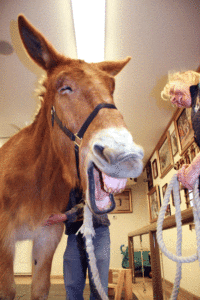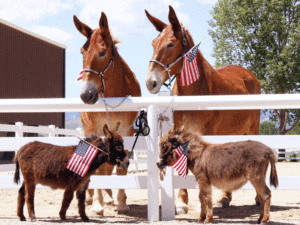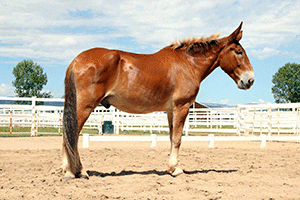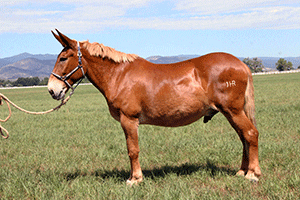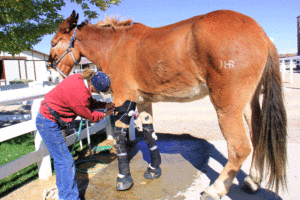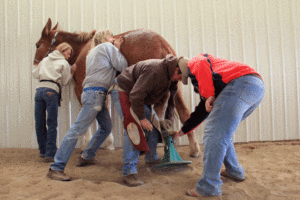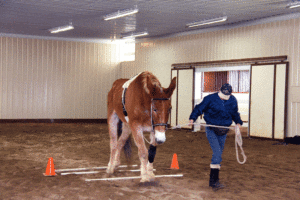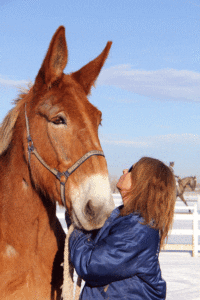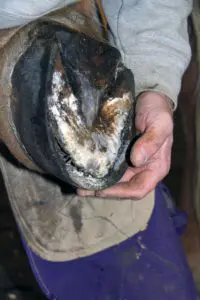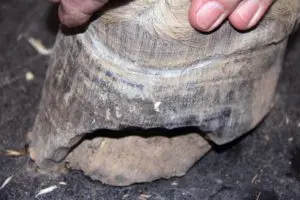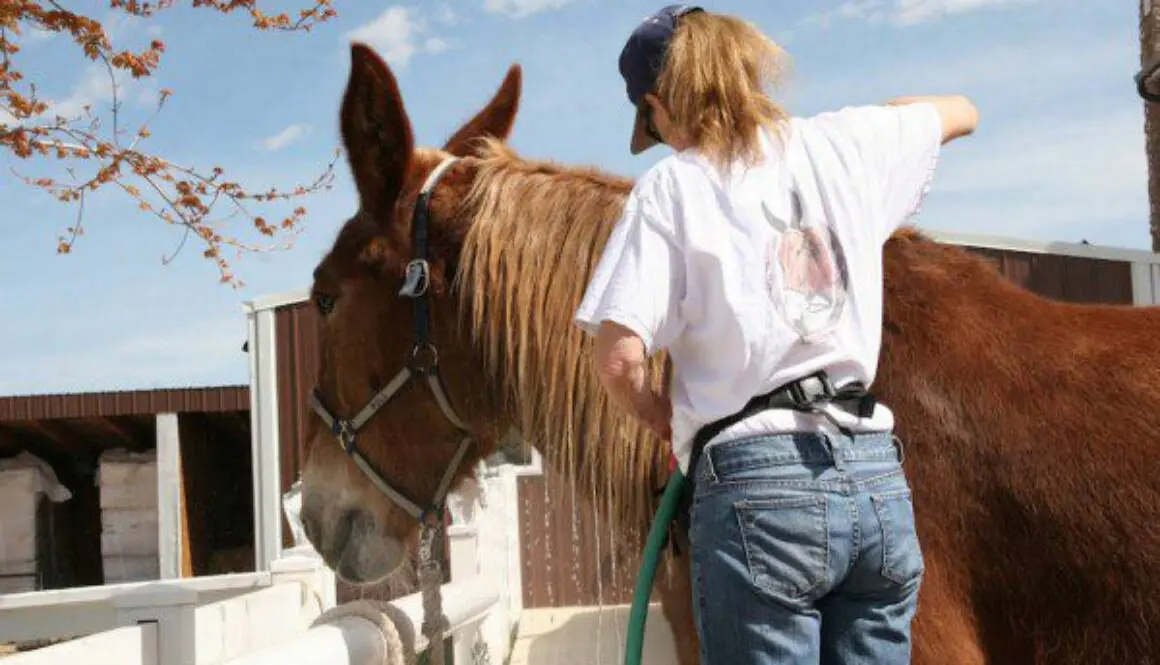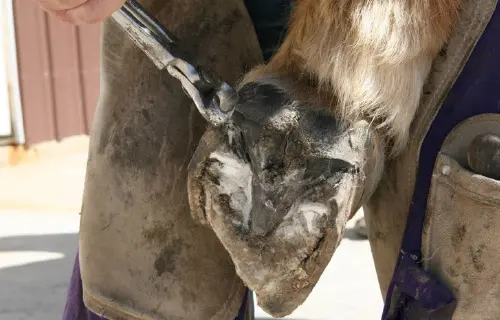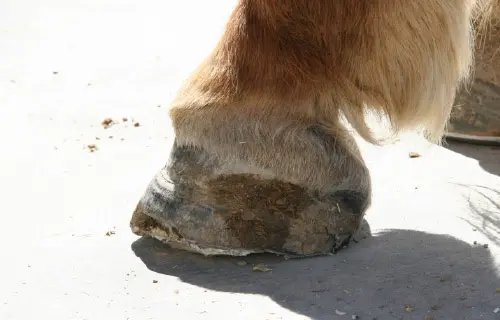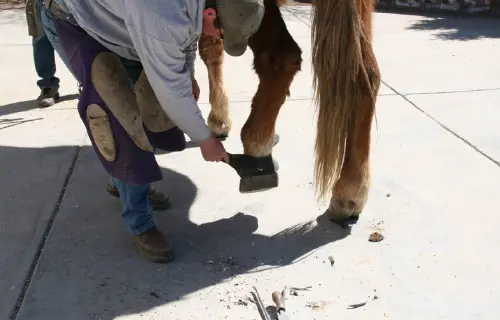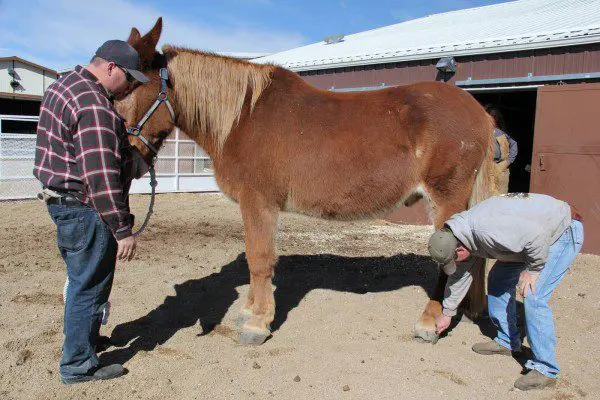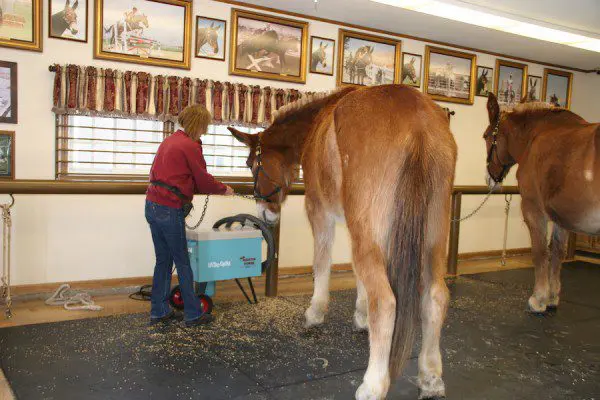By Meredith Hodges
In Part 1 of Rock and Roll: Diary of a Rescue, we learned about the discovery and rescue of Belgian draft mules, Rock and Roll, by Meredith Hodges and her team of experts. As the pair’s rehabilitation continues, the road to recovery gets tougher. But for every health setback, there is a personality breakthrough with these courageous and now-trusting gentle giants—and always a reason to hope.

By May of 2011, both mules were beginning to bond well with me and I was able to separate them during workouts. I knew I would have to develop a strong bond with Roll in case Rock didn’t make it, and we all knew the odds were not in Rock’s favor. Being alone with me in the round pen helped Roll to concentrate on the tasks at hand. His way of going was markedly improving with each new lesson.
 Both mules could now square up properly and move in a much more balanced frame, although holding that balance was intermittent. The personality of each mule began to emerge and they became more willing to play games and to be touched and kissed about their heads. Rock was much more overt about his pleasure during the massages, and we could finally tell that they were beginning to trust us.
Both mules could now square up properly and move in a much more balanced frame, although holding that balance was intermittent. The personality of each mule began to emerge and they became more willing to play games and to be touched and kissed about their heads. Rock was much more overt about his pleasure during the massages, and we could finally tell that they were beginning to trust us.
By mid-June, we were able to take the pads off Rock’s back feet and reset the shoes without the pads. He had grown three-eighths of an inch of sole on both hind feet and the rotation began to improve in one back foot. Both mules were feeling much better and were actually engaging in play during turnout. Next, we discovered that due to the concussion to his rear feet from improper use during driving in the past, Roll had side bones in his right hind foot. This caused him to twist that foot as it grew out between trims, so we put shoes on his back feet as well.
 Rock loved our newly acquired mini donkeys and, during turnout, he would stand by their pen for the better part of the day. Here they all are on the Fourth of July, 2011.
Rock loved our newly acquired mini donkeys and, during turnout, he would stand by their pen for the better part of the day. Here they all are on the Fourth of July, 2011.
By that time, Rock and Roll were both looking magnificent! Considering the extent of Rock’s past neglect and injuries, he had gained incredible muscle tone and balance. His eyes were bright and alert, his coat was shiny and his feet were much improved (although they still exhibited a hint of chronic founder).
Roll’s fat and lumpy body had changed dramatically. Now his body was more symmetrical and balanced, and he also sported a shiny coat and balanced feet. His eyes were alert and his appearance of laziness had completely vanished.
However, by the end of July, Rock once again began to lose muscle tone over his right hip and his front feet became very sore. We thought he and Roll may have been playing too hard, which could have caused Rock to injure himself again, so we separated them into adjoining pastures during daily turnout. At night they remained in their respective stalls and runs, side by side. Custom-made boots were ordered for Rock’s front feet to help alleviate the pressure, but unfortunately we had to wait until the first of November for delivery of the boots. By the time they arrived, they were of use for only about two weeks before the weather changed. The wet snow and mud became packed in the boots, causing Rock too much pain on the dropped soles of his feet.

While Rock was on three weeks of rest during August, he developed swelling in his sheath. He was treated with an anti-inflammatory for two weeks, but the swelling didn’t go down. Since his front feet seemed better, I decided to resume his physical therapy. Although the structured movement helped the swelling go down, it migrated to the midline of his abdomen. After two weeks of hot packing the abdomen twice a day, the swelling finally disappeared. Because Rock was becoming stronger and getting up and down more often, he was beginning to develop sores on his knees, fetlocks and hocks, and “shoe boils” on his underbelly (pressure sores caused by his hooves when lying down), all of which needed to be frequently tended to.
In September, once again there was swelling on Rock’s underside midline, which also seemed to cause him to get weaker musculature in the hips. The swelling was hot-packed, and it disappeared fairly quickly this time. By mid-October, Rock was lying down for prolonged periods of time—unhealthy for an equine—so his support team of three veterinarians, two equine chiropractors, his equine masseuse and I got together to assess his condition. All 2000 plus pounds of his weight was being shifted off his three bad feet and onto his left hind leg, causing it to track behind the right front when he walked. We decided on a regimen of phenylbutazone (a non-steroidal anti-inflammatory drug), minimal  exercise, plenty of rest and icing of his feet for 15-20 minutes twice daily. Things were not looking good.
exercise, plenty of rest and icing of his feet for 15-20 minutes twice daily. Things were not looking good.
No matter what was asked of him, Rock always gave it his all. We babied him through turnout, chiropractics, trims, and massage, but it finally got to the point where we could barely get his back feet off the ground to apply the hoof dressing. We decided to remove his shoes. That day, he was so weak in the hindquarters we could not replace them and couldn’t even trim the feet without running the risk of him falling down. We waited a couple of weeks before we trimmed his heels with the aid of a custom-made, six-inch equine jack stand. That seemed to help through November and part of December, but Rock still needed the Thrush Buster and Rainmaker for hoof health. He was able to tip his hind feet forward and let us have the bottoms of his feet for a few seconds at a time so the medication could be applied. Finally, he just couldn’t manage having his feet elevated at all—the pain was too great. Around this time, we noticed that the swelling had again cropped up in his midline abdomen, which led to another week of hot packing it twice a day.
 After Christmas, I decided to resume a modified version of his physical therapy. Trooper that he was, he tried with all his might, but his hips were listing terribly to the left, and the first time he went over the three one-inch ground poles, he crashed into every one of them. His third time over, he grazed just one. When I put him back in his pen, he immediately laid down. I then noticed the bulging in the coronet band of his left hind foot. He was “sinking!” We immediately called the vet and he confirmed my fear. The lamina was pulling away from the hoof wall and allowing the bones to “sink” through the sole of Rock’s hoof. It wouldn’t be long before the other feet would quickly follow suit. It was clear that he was in agony and would have to be put down, so our vet came out the ranch, loaded Rock up with anti-inflammatory and pain medications and said he would be back the next afternoon.
After Christmas, I decided to resume a modified version of his physical therapy. Trooper that he was, he tried with all his might, but his hips were listing terribly to the left, and the first time he went over the three one-inch ground poles, he crashed into every one of them. His third time over, he grazed just one. When I put him back in his pen, he immediately laid down. I then noticed the bulging in the coronet band of his left hind foot. He was “sinking!” We immediately called the vet and he confirmed my fear. The lamina was pulling away from the hoof wall and allowing the bones to “sink” through the sole of Rock’s hoof. It wouldn’t be long before the other feet would quickly follow suit. It was clear that he was in agony and would have to be put down, so our vet came out the ranch, loaded Rock up with anti-inflammatory and pain medications and said he would be back the next afternoon.
Every day for a year, I prayed for a miracle for Rock and each time I prayed, he got better. I now wondered if God would give us yet another miracle and let him live—but it wasn’t meant to be. On December 27th, 2011, surrounded by his Lucky Three family, our beautiful Rock took his last steps. We all knew it was time for us to let him go. Rock was euthanized at home and died peacefully, with his head resting in my hands.
My vet Greg Farrand informed me that the president of Colorado State University had pulled together a team for Rock’s necropsy and the preservation of his skeleton as a teaching aid for the CSU Veterinary Sciences department.
When the necropsy came back, it showed not a single fracture of Rock’s pelvis, but rather multiple old fractures in the socket of the hip joint. The bottom of the socket was almost completely gone and there was a hole the size of a dime at the top of the socket. The head of the femur had no cartilage left and there was fibrosis and cysts full of fluid the entire length of the femur stem.
I have come to realize that our courageous and noble Rock gave us more than one miracle. He had been able to live one more year of life with a severely shattered hip joint and compromised femur. He proved that our balance and core muscle therapy can work wonders! And he lived long enough to give his half-brother, Roll, the chance to bond with people who will love and care for him for the rest of his life. Thank you and God bless you, Rock. We will miss you.

To learn more about Meredith Hodges and her comprehensive all-breed equine training program, visit LuckyThreeRanch.com, MEREDITH HODGES PUBLIC FIGURE Facebook page, or call 1-800-816-7566. Check out her children’s website at JasperTheMule.com. Also, find Meredith on Pinterest, Instagram, MeWe, YouTube and Twitter.
© 2012, 2016, 2020 Lucky Three Ranch, Inc. All Rights Reserved.
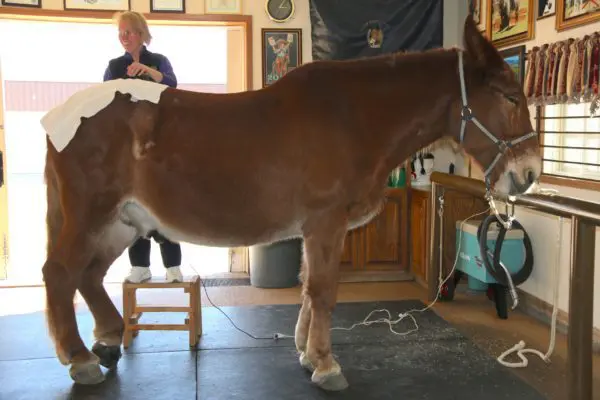 Roll has had a tough time with his left hind foot first with the White Line Disease last year and now with an abscess in his foot between the bulb of the heel and the hoof wall. Although we have been keeping a poultice on his foot and he seems to be improving, we thought it would be important for him to have a massage with his equine masseuse, Joanne Lang after his chiropractic adjustment with Dave McClain.
Roll has had a tough time with his left hind foot first with the White Line Disease last year and now with an abscess in his foot between the bulb of the heel and the hoof wall. Although we have been keeping a poultice on his foot and he seems to be improving, we thought it would be important for him to have a massage with his equine masseuse, Joanne Lang after his chiropractic adjustment with Dave McClain.





































